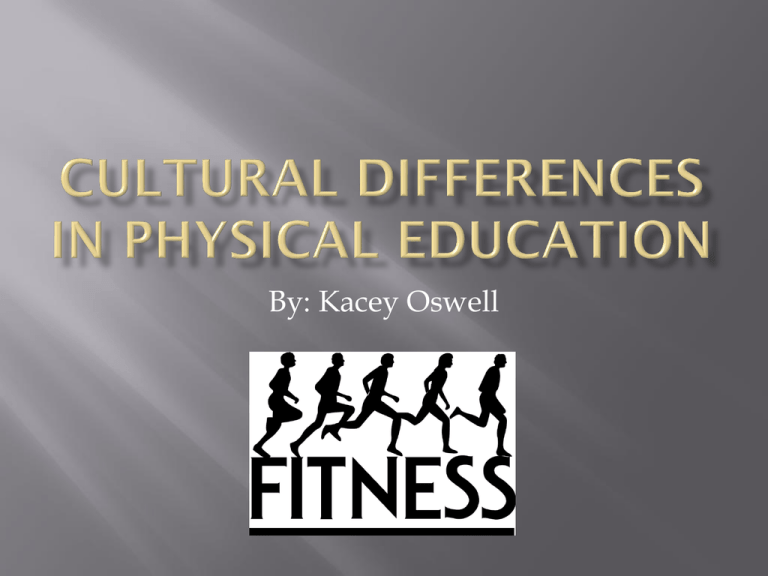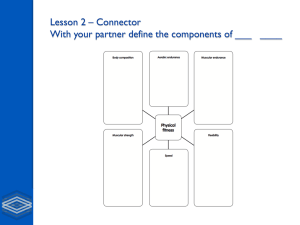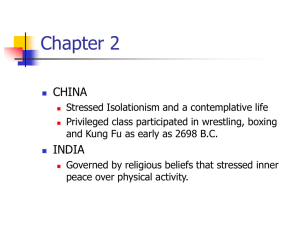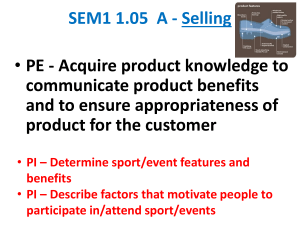Cultural Differences in Physical Education
advertisement

By: Kacey Oswell In everyday conversation, as little as 7% of a message may be expressed in words. The rest is through facial expression, voice tone, body gestures, and overall posture It may be difficult to understand nonverbal messages because different cultures have different expectations about eye contact, physical touch, body gestures, etc. PE in Japan has many similarities & differences with PE programs in the United States. Promote major outcomes related to fitness and lifelong sport and physical activity participation. Promote making a mind-body connection and learning to live a happy and cheerful life. Overall Objective: To recognize the body and mind as a whole by gaining experience in sport and understanding of health and safety One should keep a good fitness level and have a healthy attitude to make life happy and cheerful Goals: To promote a positive attitude aimed at practicing fundamental physical activities and games by having simple rules and activities Which will promote the child’s fitness. To promote an attitude favorable to practicing physical activities while being friendly with everyone and paying attention to one’s own health and safety. Goals: To promote a positive attitude towards playing sports by giving activities based on individual goals, learn sport skills based on sport’s properties, and promote fitness. Promote an attitude of fairness and cooperation, and to still give the desire to make a good effort while paying attention to one’s own health and safety. Student’s should understand how to live a healthy life and achieve physical development, and to have an attitude that will make life happy and cheerful. Goals: Promote a positive attitude towards playing sports, by giving activities based on individual goals, learn sport’s properties and controlled conditions, and promote fitness. Promote an attitude of fairness and cooperation, and still give the desire to make a good effort while paying attention to one’s own health and safety. Students should be able to understand how to prevent injury and diseases and work toward making their life healthy and cheerful. Overall Objective: To recognize the body and mind as a whole by participating in sports and through an understanding of health and safety, students should have a positive attitude toward sports, promote their fitness, and have the ability to do something good for their health on their own, and develop an attitude that will make life happy and cheerful. Students should: Develop sport skills and gain experiences by solving tasks Learn to control their own health and be aware of each physical change. Same objective Students should gain pleasurable experiences by developing sports skills; promote their fitness; have attitudes of fairness, cooperation, and responsibility; and have a positive attitude toward lifelong participation in sport. The afPE (Association for Physical Education) is the only PE and school sport subject association in the UK Their purpose is to promote and maintain high standards and safe practice in all aspects and at all levels of physical education, influencing developments in physical education at national and local levels. ‘Physical Education – The Heart of School Life’ http://www.afpe.org.uk/index.php Aim for learning and undertaking activities in PE to contribute to: Achievement Successful learners who enjoy learning, achieving, & progression. Become confident individuals who are able to live safe, healthy and fulfilling lives. Become responsible citizens who make positive contribution to society. Competence Developing control of whole-body skills and fine manipulation skills. Responding with body and mind to the demands of an activity Performance Creativity Understanding the nature of success in different types of activity. Using imaginative ways to express & communicate ideas, solve problems and overcome challenges. Healthy, active lifestyles Understanding that physical activity contributes to the healthy functioning of the body and mind. United States - “Physical Education is fitness for everyone” Japan – “Learning to live a happy and cheerful life” United Kingdom – “Physical Education – The Heart of School Life” Nakai, T. (2005, September 01). Standards and practice for k-12 physical education in japan: In both content and approach, japanese physical education exhibits similarities to, and differences from, physical education in the united states. Retrieved from http://www.eric.ed.gov/ERICWebPortal/search/detailmini.jsp?_nfpb=true&_&ERICExtSearch_SearchValue_0=EJ7279 61&ERICExtSearch_SearchType_0=no&accno=EJ727961 Nakai, T. (2005, September). Standards and practice in asia physical education. Retrieved from http://etc.usf.edu/flstandards/pe/pe in japan.pdf Wilkinson, S. (2007, September). Association for physical education. Retrieved from http://www.afpe.org.uk/index.php Curriculum Authority. (2007). Physical education. Retrieved from http://curriculum.qcda.gov.uk/uploads/QCA-07-3342p_PE_KS3_tcm8-407.pdf Speregen , K. (2005). Physical education in american's public schools. Retrieved from http://sitemaker.umich.edu/356.speregen/physical_education_and_school_performance California Department of Education. (2010, September 17). Physical education model content standards for california public schools. Retrieved from http://www.cde.ca.gov/be/st/ss/documents/pestandards.pdf RM Education. . Pe-warm up/cool down ideas. Retrieved from http://www.teachingideas.co.uk/pe/contents.htm Active Living Research. (2006). Active education. Retrieved from http://www.activelivingresearch.org/files/Active_Ed.pdf








